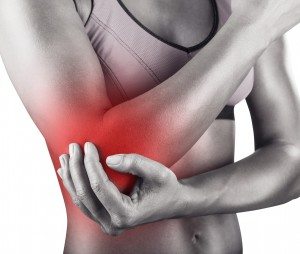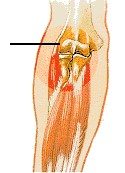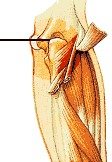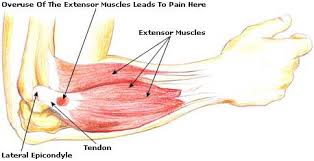WHAT IS IT?
Lateral epicondyle tendinopathy (LET), more commonly known as tennis elbow, is a condition affecting the wrist extensor tendons that attach into the lateral aspect of the elbow.

Local tendon injuries are most commonly as a result of overuse (Coombes, Bisset, & Vicenzino, 2009), compressive (Cook & Purdam, 2012) or shear forces, and most commonly presents in people between the ages of 35-54 (Coombes, Bisset, & Vicenzino, 2015).
Despite what the name suggests, this pathology occurs predominantly in the working population, affecting both desk-based and manual labour occupations. Any repetitive task (i.e., carrying, gripping or typing) involving the wrist extensors can contribute to the development of LET.
ANATOMY
The lateral epicondyle is located on the lateral aspect of the humerus, close in proximity to the elbow joint. This bony landmark serves as an attachment point for many of the wrist extensor tendons, known as the common extensor tendon. Of these wrist extensor tendons, the one most commonly implicated in LET is the tendon of extensor carpi radialis brevis (ECRB). This muscle is involved in extension and lateral movement of the wrist and hand. Wrist extension is a key component of grip and function of the fingers when typing, as to why the ECRB is commonly associated with this injury.

Contrary to common belief, LET has no inflammatory component; rather the pathology occurs due to cellular changes within the tendon. These changes within the cells result in tendon dysfunction and immature healing. The pain felt from LET then occurs from reactive nerve fibres located within the wrist extensor tendons.
There are also tears that can occur involving the lateral elbow tendons, however this is a completely separate injury to LET.
SIGNS AND SYMPTOMS
Somewhat obviously, pain over the lateral aspect of the elbow during repetitive or high load tasks is the most common symptom of LET. It is also common to experience pain into the back of the forearm.
The pain is usually notable when completing tasks that require gripping, i.e. turning a door handle or lifting a container of milk.
DO I HAVE TENNIS ELBOW?
A diagnosis of LET is made based on clinical examination.
- Tenderness on palpation over the lateral epicondyle
- Pain with grip (measure of grip strength using hand-held dynamometer)
- Pain with resisted extension of the wrist, 2nd or 3rd finger
Whilst the examination procedure to diagnose LET is simple, complex clinical reasoning skills and other tests must be performed as other conditions of the neck, shoulder and elbow can commonly mimic the symptoms of LET.
LET also has different stages, degenerative or reactive. These stages are not mutually exclusive and can occur together. It is important that the stage of disease is identified as it greatly effects treatment.
MANAGEMENT
Management of LET is highly dependent on the stage of the condition.
Reactive LET
The reactive stage of LET can be best thought of as a ‘flare-up’ of symptoms.
The best treatment options for LET in this stage include:
- Soft tissue massage
- Elbow joint mobilisations
- Rest – relative to the tasks or activities that can aggravate symptoms
- Ice
- Anti-inflammatory medication (despite the lack of inflammatory markers in this condition it has been shown that some people still benefit from taking this type of medication)
- Isometric exercises of the wrist extensors
- Treatment of other potentially contributing areas
In many cases, patients with LET have underlying degenerative components that must be addressed (as discussed below) once the reactive stage has settled.
Degenerative LET
In order for the cellular structure of the tendon to remodel and symptoms to reduce, the effected tendons must be loaded. The question of how much load is both important and difficult, and should be determined through thorough clinical assessment.
The degenerative stage of LET can generally be managed well with exercises of the wrist extensors
Exercise programs should incorporate:
- Both concentric and eccentric strengthening exercises of the wrist extensors
- Supination and pronation exercises
- Strength and control exercises of the shoulder, neck and thorax (if appropriate)
- Functional exercises (task/activity specific retraining)
Patients may also find benefits from soft tissue massage and joint mobilisations, as similar in the reactive stage.
Whilst medical options are limited for this condition, in some cases patients can have cortisone or platelet rich plasma (PRP) injections into the lateral elbow. These treatments may be helpful and can serve to provide a window of reduced pain for exercise treatments.
In very rare cases, patients have opted for surgery. Though the effectiveness of this approach is largely scrutinised by the current research.
DIFFERENTIAL DIAGNOSIS
Whilst LET is the most common cause of lateral elbow and forearm pain, other conditions can mimic its symptoms, they include:
- Radiocapitellar arthritis
- Osteochodritis dessicans (OCD)
- Radial tunnel syndrome (compression of the radial nerve)
- C6 nerve root compression (cervical radiculopathy/radicular pain)
5 TIPS FOR SELF MANAGEMENT
- Continue exercising. Many people believe that pain = damage, however in this particular condition that is not always the case. Many tasks/exercises may still use similar muscles however not aggravate or further progress the condition. If your pain is of a low level (3-4/10) and short lived after exercise, you should feel safe to continue. If you’re concerned about whether you’re negatively impacting your elbow pain, please ask your physiotherapist.
- Relative rest can be an important method of reducing pain in tennis elbow (with emphasis on the relative). If there is a repetitious or overly painful task you’re doing throughout everyday then rest or avoidance of that task may be helpful. It is counterproductive to rest completely, particularly from tasks that are not painful or aggravating.
- Ice or heat can be a helpful pain modulator in this condition. Whilst neither largely impact the condition in the long-term both can be an effective way of managing painful symptoms from exercise and daily tasks.
- Local self-massage through the forearm can also be a helpful pain modulating technique for tennis elbow.
- Topical anti-inflammatory creams such as Voltaren emulgel may be helpful in relieving symptoms. Apply them over the lateral elbow. If you’re taking blood pressure, cardiac medication or others that react with anti-inflammatory medication please consult with your G.P. before starting this treatment.
RETURN TO ACTIVITY GOALS
People who have tennis elbow often make a full recovery in strength and function. Recovery times are quite variable amongst individuals. Current research is suggesting the average time to recover is approximately 9 months, though some can recover in as quick as 3 and others may take up to 2 years.
Lateral epicondyle tendinopathy (LET) or lateral epicondylalgia, commonly known as tennis elbow, is a condition affecting the wrist extensor tendons that attach into the lateral aspect of the elbow and is aggravated with activities that involve repetitive gripping. Elbow tendon injuries are most commonly a result of overuse, compressive or shear forces, and most commonly presents in people between the ages of 35-54 years. Despite what the name suggests, this pathology occurs predominantly in the working population, affecting both desk-based and manual labour occupations. Any repetitive task (i.e., carrying, gripping or typing) involving the wrist extensors can contribute to the development of LET
How is lateral elbow pain treated?
Management of LET is highly dependent on the stage of the condition.

Reactive LET
The reactive stage of LET can be best thought of as a ‘flare-up’ of symptoms.
The best treatment options for LET in this stage include:
· Soft tissue massage
· Elbow joint mobilisations
· Rest – relative to the tasks or activities that can aggravate symptoms
· Ice
· Anti-inflammatory medication (despite the lack of inflammatory markers in this condition it has been shown that some people still benefit from taking this type of medication)
· Isometric exercises of the wrist extensors
· Treatment of other potentially contributing areas
In many cases, patients with LET have underlying degenerative components that must be addressed (as discussed below) once the reactive stage has settled.
Degenrative LET
In order for the cellular structure of the tendon to remodel and symptoms to reduce, the effected tendons must be loaded. The question of how much load is both important and difficult, and should be determined through thorough clinical assessment.
Research has shown, the degenerative stage of LET can generally be managed well with exercises for the wrist extensors.
Exercise programs should incorporate:
· Both concentric and eccentric strengthening exercises of the wrist extensors
· Supination and pronation exercises
· Strength and control exercises of the shoulder, neck and thorax (if appropriate)
· Functional exercises (task/activity specific retraining)
Patients may also find benefits from soft tissue massage and joint mobilisations, as similar in the reactive stage.
Whilst medical options are limited for this condition, in some cases patients can have cortisone or platelet rich plasma (PRP) injections into the lateral elbow, however the evidence supporting it's use is limited. In very rare cases, patients have opted for surgery. Though the effectiveness of this approach is largely scrutinised.
All Physica practitioners have received extra training in the diagnosis and management of Tennis Elbow, as the research suggests, exercise programmes designed and guided by physiotherapists are the first line treatment of choice.
SELF HELP
Acute Management 0-48 hrs
Initially, the RICE principles should be applied in the first 48-72 hours:
Rest – Rest from activities that cause pain
Ice – Ice the affected area 20 mins every 2 hours
Compress – Use a compression bandage to minimise swelling,
Elevate – Elevate the lower limb to minimise swelling
Treatment
Gentle exercises can be commenced soon after the injury occurs. Rehabilitation will include a range of manual techniques as well as strengthening, stretches, sport specific drills and a graded return to sport. Strengthening of the muscle is essential to enable and optimal recovery and these exercises are progressed as the muscle heals.
When can I return to activity
01
Your Physiotherapist will advise you as to when you are safe to return to sport/activity.
03
If you do not have a Physiotherapist download a program below and contact uswith any questions you may have?
02
You can speed things up by an accurate rehabilitation program. Your Physiotherapist will provide you with exercsies and a management plan.
How do I make an appointment?
Select from the page menu your closet Physica Clinic. We look forward to you attendin.
Other causes of elbow pain
Golfers Elbow medial epicondylalgia)
The causes of golfer's elbow are similar to tennis elbow but pain and tenderness are felt on the inside (medial) of the elbow, on or around the joint's bony prominence.
Signs and symptoms of Golfers Elbow?
The causes of golfer's elbow are similar to tennis elbow but pain and tenderness are felt on the inside (medial) of the elbow, on or around the joint's bony prominence.
ASSESSMENT
• Recurring pain on the inside of the upper forearm just below the bend of the elbow; occasionally, pain radiates down the arm toward the wrist.
• Pain caused by gripping , often worse with an flexed elbow.
• Difficulty bending and straightening the arm .
• Pain that typically lasts for 6 to 12 weeks; the discomfort can continue for as little as 3 weeks or as long as several years.
Bursitis
Often due to excessive leaning on the joint or a direct blow or fall onto the tip of the elbow.

A lump can often be seen and the elbow is painful at the back of the joint.
Signs and symptoms of Olecranon Bursitis?
Often due to excessive leaning on the joint or a direct blow or fall onto the tip of the elbow.
A lump can often be seen and the elbow is painful at the back of the joint.
ASSESSMENT
The diagnosis is very easy and simple and your physiotherapist or medical practitioner will be able to diagnose.
The causes of golfer's elbow are similar to tennis elbow but pain and tenderness are felt on the inside (medial) of the elbow, on or around the joint's bony prominence.


Signs and symptoms of Golfers Elbow?
Somewhat obviously, pain over the lateral aspect of the elbow during repetitive or high load tasks is the most common symptom of LET. It is also common to experience pain into the back of the forearm. Pain is often aggravated by gripping objects or by extending the middle finger.
ASSESSMENT
• Recurring pain on the inside of the upper forearm just below the bend of the elbow; occasionally, pain radiates down the arm toward the wrist.
• Pain caused by gripping , often worse with an flexed elbow.
• Difficulty bending and straightening the arm .
• Pain that typically lasts for 6 to 12 weeks; the discomfort can continue for as little as 3 weeks or as long as several years.

